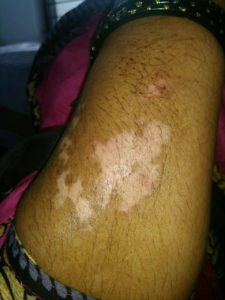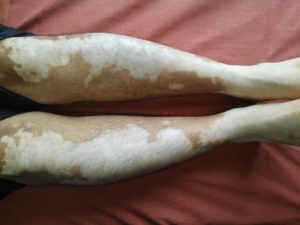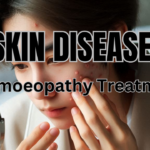

Vitiligo – A skin problem which does not kill the patient but causes social embarrassment and depression. Hence counseling of the patient is necessary.
Vitiligo was observed very early in history, and most ancient civilizations and religions had references to people who lacked pigmentation. Atharvaveda written in 1400 BC describes vitiligo. The name “vitiligo” was first used by the Roman physician Aulus Cornelius Celsus in his classic medical text De Medicina written in first century. In 200 BC, the Indian Manu Smriti described “Sweta Kushtha” meaning white disease referring to vitiligo. Pop music icon Michael Jackson revealed in an interview with Oprah Winfrey in February 1993 that he had vitiligo. This was confirmed by the autopsy report following his death in 2009. P Sathasivam, who is the current Governor of Kerala, in office since 2014, has vitiligo. He previously served as the 40th Chief Justice of India from 2013 to 2014.
Melanocyte
Melanocyte is pigment forming cell, present in skin, hairs, mucous membrane, eyes, ears and brain. Melanocyte traps tyrosine and converts into melanin pigment. 1 Melanocyte distributes melanin to 36 keratinocytes. Eumelanin is dark brown in color and pheomelanin is red brown or yellow in color. Different concentration of eumelanin and pheomelanin gives different color to skin. Negros will have more eumelanin, Caucasians and Mongoloids will have more pheomelanin.
Loss of melanocytes results in loss of melanin production, hence produces pale patches to white patches in skin and mucous membrane – vitiligo.
Causes
Although multiple hypothesis have been suggested as potential triggers that cause vitiligo, studies strongly imply that changes in the immune system are responsible for this condition. Genetic susceptibility and environmental factors both thought to play a role in development of vitiligo lesions. Vitiligo is sometimes associated with autoimmune and inflammatory diseases such as Hashimoto’s thyroiditis, scleroderma, rheumatoid arthritis, type 1 diabetes, psoriasis, Addison’s disease and systemic lupus erythematosus. Patients who are stigmatized for their condition may experience depression and mood disorders. Vitiligo is also seen in animals. Cows, buffalo, dogs, cats and pigs all suffer from vitiligo.
Signs and symptoms


The difference in the color of race is because of the presence of Eumelanin and Pheomelanin.
More the eumelanin, more the brown black color. More the pheomelanin, more the fairer color. At the time of birth, there is normal presence of melanin pigment. As the child grows, and then only pigment start disappearing from the body and giving rise to pale to white color to skin. Usually around 5th year, 15th year and 50th year melanin pigment start disappearing from the skin. The patches are initially small, but often grow and change shape. When the skin lesions occur, they are most prominent on the face, hands and feet. The loss of skin pigmentation is particularly noticeable around body orifices, such as the mouth, eyes, nostrils, genitalia, and umbilicus. Some lesions have increased skin pigmentation around the edges. The mucous membrane of mouth and genitalia also loose pigment and become white patches. The hairs of scalp, hairs of body surface also loose pigment and become white.
Classification
Vitiligo can be subdivided into
- Non-Segmental Vitiligo (NSV) and
- Segmental Vitiligo (SV)
In non segmental vitiligo, there is usually some form of symmetry in the location of the patches of depigmentation. New patches also appear over time and can be generalized over large portion of the body or localized to a particular area. NSV is further grouped into
- Generalized vitiligo or vitiligo vulgaris: The most common pattern, the areas of depigmentation present all over the body in patches. Patches are seen over face, trunk, and extremities.
- Universal vitiligo: depigmentation encompasses most of the body.
- Focal vitiligo or vitiligo areata: one or a few scattered white patches in one area, most common in children.
- Acrofacial vitiligo: white patches present only on face, hands and feet.
- Lip-tip variety: white patches present only on lips and tips of fingers and toes.
Segmental vitiligo: it tends to affect areas of skin that are associated with dorsal roots from the spinal cord and is often unilateral. It is more stable. It responds to topical treatment.
Differential diagnosis
Conditions with similar symptoms include the following:
Post inflammatory hypo pigmentation following burn injuries and also chemical burns. This type of hypo pigmentation and depigmentation is called leucoderma. Good history will differentiate vitiligo from leucoderma.
Albinism is also white skin, but the cause of white skin is absence of melanin pigment by birth. Albinism is seen in animals also, birth of white lion and white tigers in zoos.
Old age people will develop white macules, which are called idiopathic guttate hypomelanosis. They are age related. Sometimes they feel embraced and hide their patches from their own family members.
Leprosy may present hypo pigmented patches. Careful examination will show, the patches are anesthetic also.
Treatment
Benign nature of vitiligo has to be explained to all school children, school teachers and parents. If a child is having white patches, school friends, teachers and parents should not differentiate him in the class room. This disease is not contagious. Sitting along with vitiligo child in the class room, eating with child, playing with the child will not spread vitiligo to friends.
On 25th June all over World vitiligo day is observed. True nature of vitiligo is explained to all people all over the World.
The lesions may regress on their own; patient may get back the pigment in all patches. The patches may remain stationary for many years. The patches may start spreading all over the body. The treatment may bring back pigment over 6 months to 2-4 years. Sometimes the treatment may be ineffective. The course of vitiligo is unpredictable and the nature of treatment is also unpredictable.
Topical steroids, tacrolimus, psoralens are main stay of vitiligo treatment. Systemic steroids and Phototherapy are also helpful in vitiligo cases. Cosmetic camouflage and surgical treatment are tried where medical line of treatment is not effective.


Dr K Hanumanthayya
Dermatology Department
Vydehi Institute of Medical Sciences & Research Centre – Bangalore
Ph: 080 28413381/2/3/4
www.vims.ac.in











